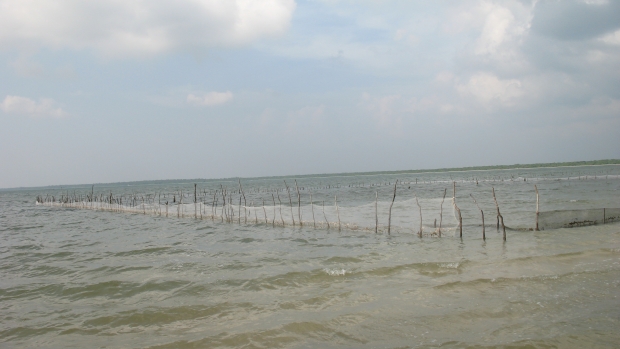Grants :: Small Grant Facilities :: Providing supplementary income to the coastal community in Northern Mannar through establishing of healthy mother plant stock of Kappaphycus alvarezii (Eucheuma cottonii) meet future demand of seedlings of seaweed farming industry in Sri Lanka
Providing supplementary income to the coastal community in Northern Mannar through establishing of healthy mother plant stock of Kappaphycus alvarezii (Eucheuma cottonii) meet future demand of seedlings of seaweed farming industry in Sri Lanka

Sea weed culture site, Mannar © Kumudini Ekaratne, IUCN SL, 2015
Objectives
Establish a healthy mother plant stock (10 tonnes per cycle after completing the project) year round to meet the demand of seaweed industry in Sri Lanka.
Background
Seaweeds are marine algae (organisms that make their own food like plants but lack the specialised internal cells to transport food and water). Kappaphycus alvarezii is an alga that contains carrageenans — which are important commercially, as thickening and gelling agents used in the confectionary industry. There is a viable export market for dried seaweed of this alga, which is found in the shallow marine waters of Sri Lanka. Seaweed culture is now becoming a popular livelihood in coastal areas.
In the Mannar District, communities recovering from a three-decade long civil unrest have limited options for alternative livelihoods. This project provides support to communities to commence culture of seaweed.
Interventions:
• A programme to create awareness about seaweeds and seaweed farming was conducted for 21 members of the Kumilamunai Punitha Anthonyar Fishermen’s Cooperative
Society (FCS).
• Five members of this cooperative were selected as beneficiaries.
• A training programme on farming and plant stocking was held for 21 members of FCS, and another on bookkeeping was held for 20 members.
• Three farms — with each plot (15.24 m X 30.48 m) containing 30 culture lines and each with 40-46 seaweed bunches — were established.
• A cyclone and fl oods that occurred during the latter part of 2011 destroyed these three farms.
• Later, two new farms were setup and stocked with seaweed. An additional 32,000 sea cucumbers that were collected from the wild by collectors but not accepted by buyers because of their small size, were also introduced.
• An awareness programme was then conducted on sea cucumber rearing.
Target beneficiaries
Five families of Kumilamunai Punitha Anthonyar Fishermen’s Cooperative Society (FCS).
Outputs
• The harvest from two farms — two hundred and fifty sea cucumbers (nearly 6 kg) have been sold through the cooperative society at a rate of about 8,000 LKR (60 USD) per kilogramme.
• In late May, 2012 18 kg of seaweed at 200 LKR (1.5 USD) per kilogramme was sold as mother stock to another grower in the Puttalam area.
Accomplishments and challenges
Although it is not possible to make any inference about the impacts of seaweed culture, there has been a marked improvement among the farmers in this community in the harvesting of cage-reared sea cucumbers. Prior to this project, sea cucumbers were caught at all stages of growth and sold to buyers. Sea cucumbers that were not accepted by buyers were thrown back into the sea, causing immense wastage on an already stretched resource. Now, the farmers know what is acceptable and when to harvest the farmed sea cucumbers.
Contributions to cross-cutting themes
Beneficiaries were all males.
Lessons Learned
- Because there are no recorded data for seawater quality at shallow coastal areas in the region which are suitable for seaweed farming, it is essential to keep monitoring water quality and growth performance at least for another year before investing in larger-scale projects for seaweed farming in Sri Lanka
- According to the analysis of salinity and temperature of water, it appears that changes in water temperature have a stronger impact on seaweed growth than salinity changes
- It is also necessary to be cautious about expansion to a bigger scale, in the light of several studies about this species as an invasive species in the Gulf of Mannar. Much more research on its basic biology is needed before this second step.
- A community-based livelihood project is successful only if returns are high. It appears that small-scale seaweed farming is not attractive financially to fishing communities in the region, Conversely, sea cucumber farming brings in much higher profits and is readily accepted by communities as an alternative source of income. As a result, the project of seaweed culture per se was not successful.
Project Facts
Country
Location
Kumilamunai in northern Mannar, Sri Lanka
Topic
Duration
1st May 2011 to 31st Oct 2012
MFF Grant Amount
LKR 652,000/-